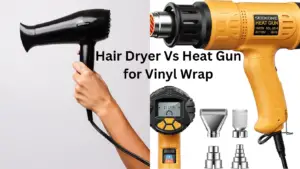This post may contain affiliate links which means I may receive a commission for purchases made through links.

In general, a heat gun is necessary when applying vinyl wrap to your car as it allows you to heat and stretch the material and ensure it adheres properly to the surface. Without it, it is almost impossible to make the edges look smooth and make the vinyl wrap adhere properly to the car’s surface.
In addition, a heat gun helps to shrink the vinyl wrap to deliver a seamless and tight fit. Not to forget that you can also use it to remove the vinyl wrap with ease once you’re ready to remove it.
However, in an attempt to save some money while wrapping your car, you may be tempted to use a hair dryer instead of a heat gun. After all, both the heat gun and hair dryer produce hot air.
But is it okay to do that? Can you use a hair dryer instead of a heat gun when wrapping a car? Well, let’s find out in the detailed comparison of hair dryer vs heat gun for vinyl wrap!
What is a heat gun?
A heat gun is a handheld automotive device that emits a stream of hot air, with temperatures ranging from 100 to 700 deg C. Most heat guns are in the shape of a handgun, but some models have an inline design.
Whichever the case, different heat gun models operate at different temperatures and airflow for various applications. For instance, you can use these devices to heat shrink wrap, strip paint, and shrink wrap packaging, weld and bend plastic, and remove adhesive.
Also, they are sometimes used with electronic work to rework and desolder circuit board components.
Another notable feature of a heat gun is that it consists of a heating element and an electric fan. More notably, a heat gun is more expensive, more advanced, and poses more danger for the user than a hair dryer.
Heat gun applications
As already mentioned, different heat gun models operate on different temperatures and airflow as they’re intended for different applications. The most common application of this tool include;
- Removing paint (minimum of 750 deg C)
- Removing flooring (around 350 deg C)
- Defrosting fridge (250 deg C)
- Fixing frozen water hoses (1150 deg C)
- Plastic flex (250 deg )
- Frozen locks (350 deg C)
- Dry Painting (250 deg C)
In the automotive industry, heat guns are used for tasks like stripping car paint and shrink-wrapping. Moreover, you can use a heat gun to apply car vinyl wrap and place a window tint evenly.
Even better, you can use it to apply heat-activated glue to fix some dents and blemishes on your car. Plus, you can use this tool to remove old adhesives that are difficult to remove by other methods.
What is a hair dryer?
As the name suggests, a hair dryer is a device that was originally designed to dry damp hair. It is widely used for styling hair as it generates hot air that helps hair stay how the user wants.
Similar to a heat gun, a hair dryer is equipped with an electric fan and a coil. Other than that, these devices vary from one another in terms of temperature production power, and usage.
Talking of usage, a hair dryer is mainly used in;
- Removing pinched (non-rusted ) screws
- Drying vegetables after they’ve been washed
- Pulling out the contact papers
- Removing dust from hard-to-reach places
- Thawing vegetables and meat from the freezer
- Stretching an over-tight pair of shoes
- Removing wrinkles from clothing
Notable Differences: Heat Gun Vs Hair Dryer
Heat Output
While hair dryers and heat guns have similar functions, they’re intended for completely different applications. Besides, a hair dryer is mainly intended for drying your hair. For that, the heat output of a hair dryer is much lower compared to that of a heat gun.
Generally speaking, a standard hair dryer has a maximum temperature of about 140 deg C. However, most hair dryers have a heat output of between 30 and 100 deg C to ensure that they don’t ruin your hair.
Surprisingly, while this temperature may sound insufficient, it can handle many more workshop tasks including removing pinched screws.
In comparison, heat guns usually produce temperatures ranging from 100 to 700 deg F. This makes them ideal for handling tasks that need a high amount of temperature like removing paint, and shrink wrapping.
Temperature Control
Almost all modern heat guns have some temperature adjustment mode. This allows you to adjust the convenient temperature with ease while working. For instance, most heat guns have dial options and temperature marks to allow you to select the exact temperature.
Also, some advanced heat guns have an LCD monitor that you can use to check the current temperature, but you’ll have to spend more.
Hair dryers, on the other hand, usually have 2 temperature adjustment options; low- and high-temperature modes. While some advanced hair dryers have a few adjustment options, you’ll not get the right heat output you would get with a heat gun.
Typical Applications
Apart from drying hair, a hair dryer performs several other tasks, thanks to advancements in modern technologies. For instance, you can use this heating device to remove stickers, labels, and even candle wax from various surfaces.
Also, you can use a hair dryer to mold plastic glasses and dry the water absorbed by wooden surfaces.
Similarly, you can use an automotive heat gun to perform many tasks, including applying car vinyl wrap. Even better, heat guns work at both low and high temperatures as they have a wider and more precise temperature range.
For that, you can use them to remove torn paintings and speed up the drying process of painting. Moreover, you can use a heat gun to remove rusty bolts and bend materials like plastic.
One thing you need to note when using a heat gun though is that different tasks require a different temperature range. For instance, if you intend to use the tool to remove rusty bolts, you’ll need a device that can produce a heat output of at least 650 deg C.
Price
A Hair dryer vs heat gun for vinyl wrap does not cost much. However, if you want a heating device that will last for a long time I’d recommend spending some extra bucks.
That said, the average price of buying a hair dryer ranges from $10 to $20, depending on the quality and brand. On the other hand, the cost of buying a heat gun ranges from $20 for low-priced but effective models to $100 for units that are intended for industrial works.
Hair Dryer Vs Heat gun for Vinyl Wrap; Can you use a hair dryer instead of a heat gun for a vinyl wrap?
Although both appliances produce heat, you should not use a hair dryer instead of a heat gun when vinyl wrapping your car. This is because a heat gun has a higher and more concentrated heat output than a hair dryer, making it much more suitable for tasks like vinyl wrapping.
Moreover, the best heat guns for vinyl wrapping have adjustable temperatures, allowing you to choose the perfect temperature to complete the task.
Better yet, this makes a heat gun a more precise tool for heating specific areas of the vinyl wrap to avoid wrinkles and bubbles.
Lastly, if you were to use a hair dryer instead of a heat gun to vinyl wrap your car, you’d take a long time to complete the task, yet the results will not be as good. After all, a heat gun can reach a maximum temperature of around 700 deg C, while a hair dryer can only reach a maximum temperature of 140 deg C.
So, if you want to save time and achieve a professional-looking car vinyl wrap, I’d recommend you stick to a heat gun instead of using a hair dryer!


Leave a Reply